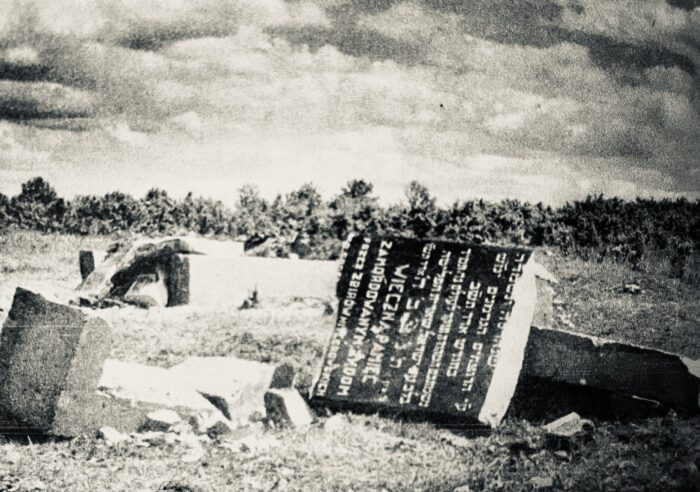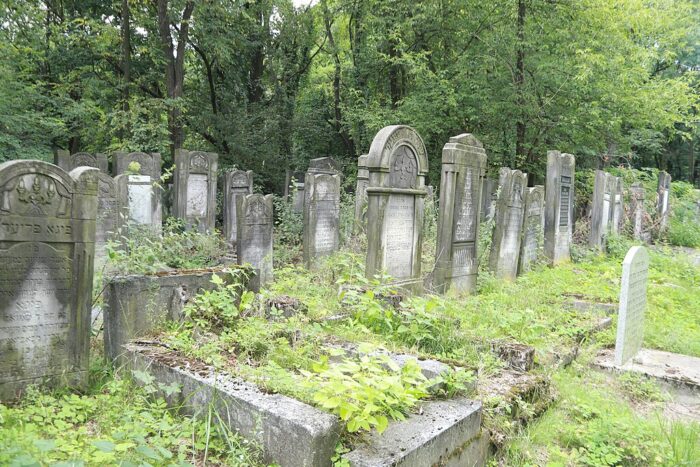The fate of Jewish cemeteries in Poland has been abysmally dismal.
Many of the estimated 1,200 Jewish graveyards in Poland, a country once home to 3.3 million Jews, have been bulldozed, built over and vandalized. Still others, having been totally neglected due to the mass murder of the Jewish population during the Holocaust, have been taken over by foliage and covered by a forest of trees, weeds, bushes and flowers.
Nearly 50 years ago, my friend Henry Srebrnik and I visited one such forlorn cemetery in the central Polish city of Czestochowa, the birthplace of his late parents. It is a sight neither of us will ever forget. The lesson to be learned here is clear: What seems vibrant today may well be decrepit tomorrow.

Jewish cemeteries were largely destroyed or repurposed during three separate eras: The six-year German occupation of Poland from 1939 to 1945, the communist period from the late 1940s until 1989, and the restoration of democratic governance from 1990 onward.

Krzysztof Bielawski, a Polish historian specializing in Jewish studies, and currently the project coordinator at the Foundation for the Preservation of Jewish Heritage, addresses this oft- overlooked topic in The Destruction Of Jewish Cemeteries In Poland, published by Academic Studies Press.
Rigorously researched and written in an accessible style, it is a welcome addition to Polish historiography. His book, however, tends to be repetitious in its presentation of details. This flaw can be overlooked in light of his thorough approach to the subject.
For much of the postwar period, the history of Jewish cemeteries was never fully documented, particularly during the communist interregnum. It was not until the 1990s that a growing interest in Jewish cemeteries developed, resulting in a profusion of monographs, books, albums and websites. Bielawski himself runs one such site.
As he observes, Poles usually blame the Nazis for the destruction of Jewish cemeteries, but in fact ordinary people and postwar governments participated in this grim process. Consequently, this is a difficult subject for the average Pole.
Placing the topic into its proper historical perspective, Bielawski takes a reader back several centuries, pointing out that the destruction of Jewish cemeteries initially started in Przemysl and Sandamierz in 1571 and 1655 respectively during anti-Jewish riots and the Polish-Swedish war.
In the second half of the 19th century, Christians plundered Jewish graves under the baneful influence of antisemitic superstitions. Jewish gravestones were smashed by peasants in Oswiecim in 1918 and 1919. Yet oddly enough, the decade of intensified antisemitism in the 1930s did not lead to many acts of vandalism in Jewish cemeteries.

By the beginning of the 20th century, he adds, the oldest Jewish cemeteries, dating back hundreds of years, had fallen into disrepair due to soil erosion and a lack of regular maintenance.
The outbreak of World War II in 1939 resulted in widespread damage to Jewish cemeteries. The first one to be violated was in Krzepice, a town near the German border, when German tanks knocked down the perimeter wall of a cemetery. Shortly afterward, the Germans dug up the graves of a Chassidic dynasty in Radomsko. Jewish forced laborers and prisoners of war were deployed to do the dirty work.
As Bielawski says, the German occupiers used gravestones on a massive scale to harden roads and pavements in the Treblinka and Majdanek concentration camps and to build curbs in towns and cities. They also used gravestones as a building material and to tile walls and construct pillars.

Polish farmers put gravestones to use in the construction of pig pens. In Krakow, burial registers in cemeteries were burned. In Brzeziny, headstones were used for target practice. And in Konin, the Jewish cemetery was transformed into a military training ground.
During the Warsaw uprising in 1944, fierce battles were fought in Warsaw’s Okopowa Street cemetery, causing significant destruction. Local residents helped themselves to headstones for their construction projects. Still others plundered graves, prying gold dental crowns from corpses.
Bielawski believes that the desecration of Jewish cemeteries was a nation-wide phenomenon on the part of some Poles.
While the Red Army in postwar Poland decamped in Jewish cemeteries in Krakow and Zamosc, the Polish army used gravestones to build an airport in Nowy Targ.
The municipal authorities in Rzeszow and Baligrod authorized the use of gravestones to shore up the banks of the Wislok River and to renovate the market square. In Lodz, a major road bisected the oldest Jewish cemetery.
Jewish cemeteries were often converted into city parks, squares and playgrounds. Cemetery buildings were repurposed to build warehouses, carpentry shops and council housing. Cemeteries also were transformed into sand pits, with gravel and crushed human bones being used in the manufacture of prefabricated panels for apartment blocks.

The collapse of communism brought about radical changes in the state’s attitude to cemeteries. From that point forward, in theory at least, burial sites were designated as sacred grounds that could be utilized for no other purpose. But in the absence of enforcement mechanisms, Jewish cemeteries were ransacked. Bielawski cites several glaring examples, including the construction of a road through a cemetery in Sandomierz during which human remains were found.

On the other hand, the democratization of Poland resulted in the formation of Catholic associations dedicated to caring for cemeteries. “Motivating these people (was) a desire to care for the graves of former residents of their town, concern for their cultural heritage, and an interest in Jewish culture,” writes Bielawski. “Activities include cleaning graves, repairing cemetery infrastructure, conservation of gravestones, and various forms of commemoration, documentation and popularization.”

Polish Jews assumed a role in cleaning up Jewish cemeteries, recovering stolen gravestones and commemorating the victims of the Holocaust. In 1995, Lodz city council, in conjunction with the Union of Former Lodz Residents in Israel and the World Restitution Council, established a committee to maintain the city’s main Jewish cemetery.
Similar initiatives were launched in, among other cities, Bialystok, Chmielnik and Rozan.
But as Bielawski observes, the small Jewish community in Poland, a pale shadow of its former self, lacks the capabilities to properly care for all its cemeteries.
The Roman Catholic Church, the highest authority for many Poles, took a passive attitude toward the destruction of cemeteries. But in 1946, the bishop of Lublin, Stefan Wyszynski, asked parishioners to respect the cemeteries of all religions. And in 2015, the Committee for Dialogue with Judaism of the Polish Episcopal Conference issued a statement calling for the restoration of Jewish cemeteries.
Yet the looting of Jewish cemeteries continues unabated, and illegal dumps have despoiled some cemeteries in provincial towns.
Jewish cemeteries have caught the eye of criminal gangs and sex workers. And antisemites have daubed graves with despicable slogans.
Jewish cemeteries signify that Jews were once a large and important minority in Poland. But with 90 percent of Polish Jews having perished during the Holocaust, and with the majority of survivors having emigrated since the 1950s and 1960s, Jewish links to Poland have gradually faded.
And so Jewish cemeteries in Poland have been shunted to the margins, relics of a bygone era that grows exceedingly dim with the passage of time.

